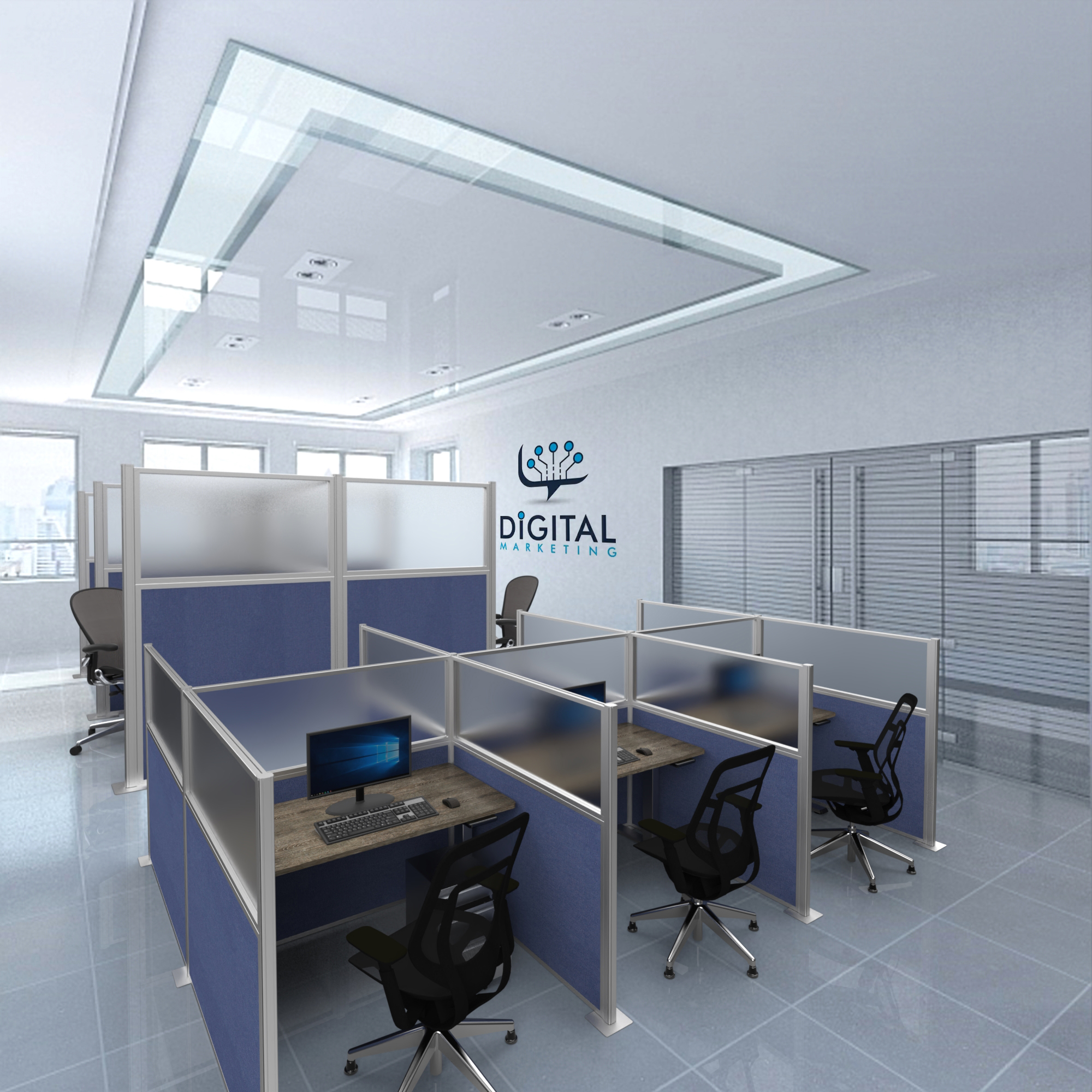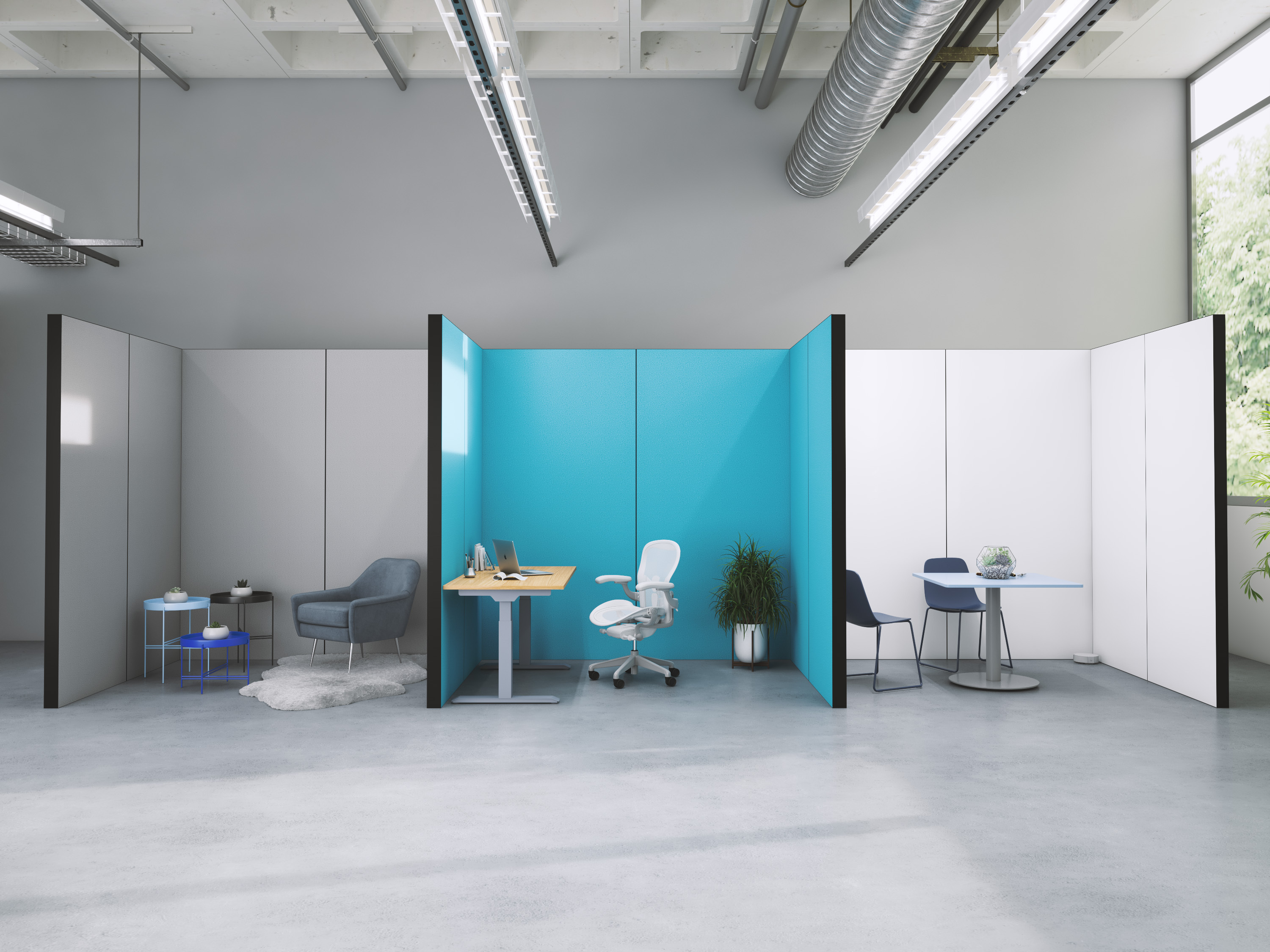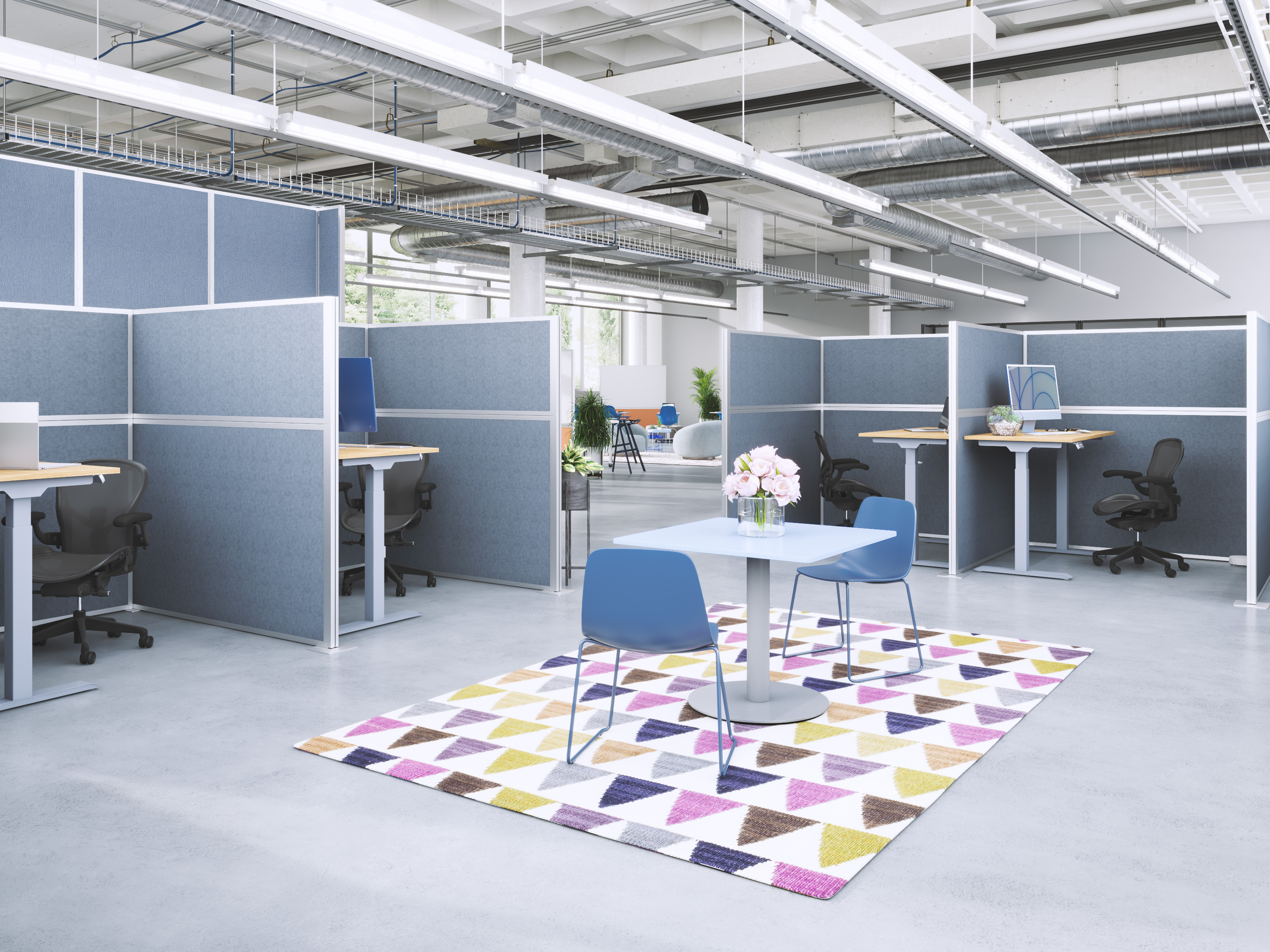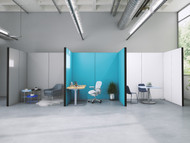A Brief History of the Cubicle
Posted by Kate Murphy on Mar 13th 2025
Work trends come and go—just like high-waisted acid-wash jeans, vinyl records, and shag carpet. Office furniture is no different. From private offices to open floor plans and cubicles, the workplace has seen it all. While cubicles have been praised, criticized, and even declared “dead,” this office staple keeps making a comeback.
The global cubicle and partition market was valued at approximately $8.2 billion in 2024 and is projected to grow to $12.2 billion by 2033. Clearly, cubicles are and remain a big industry. But how did they evolve from a groundbreaking innovation to a criticized office staple, and now back to a workplace essential? Let’s take a closer look at the history of the cubicle.
Watch Versare's YouTube series "The Brief History of the Cubicle" here:
The Origins of the Cubicle
Office design has long been shaped by competing philosophies of openness and structure. In the early 20th century, architect Frank Lloyd Wright championed the open-office concept, envisioning spacious, collaborative environments that fostered fluidity and community while rejecting rigid, compartmentalized layouts.
However, as businesses grew, the drawbacks of fully open spaces became clear, leading to a push for more functional office designs and sparking early innovations in workspace layout. In the 1950s, Germany’s “Bürolandschaft” (office landscape) movement, developed by the Quickborner consulting group, aimed to humanize offices by emphasizing flexibility and collaboration. Rejecting rigid, hierarchical layouts, it used furniture, plants, and curved desks to create informal zones that encouraged interaction while maintaining some separation. This approach fostered a more democratic and dynamic work environment.
While Bürolandschaft’s principles influenced European offices, American corporations were slower to adopt them. For years, workers were confined to large, open spaces filled with rows of desks. By the 1960s, the need for a more structured yet adaptable workspace became apparent, leading Robert Propst, a designer and researcher at Herman Miller, to develop a revolutionary concept: the “Action Office.”
The Action Office was designed to accommodate different types of work—some tasks required quiet focus, while others benefited from collaboration. Unlike the traditional open plan office, the Action Office was:
-
Modular and adjustable, allowing for easy reconfiguration.
-
Designed for movement and ergonomics, featuring standing desks, multiple surfaces, and varied layouts.
-
Focused on worker productivity, promoting efficiency and well-being.
-
Featured acoustical panels to help insulate workers from the noise of telephone calls and typing.
American offices didn’t fully embrace the Action Office plan, as its components were designed more for individual workers than for large companies needing to accommodate many employees and assembly was complicated and expensive. Executives simplified the concept into a cheaper, more static version that could pack in more workers, leading to the mass adoption of what we now recognize as the cubicle.
While the cubicle kept the core idea of giving employees their own workspace, it lost the flexibility Propst had envisioned. Instead of customizable, dynamic layouts, businesses chose uniform, three-walled enclosures that could be arranged in neat rows, making the most of available office space.
Ironically, Propst later criticized what his invention had become, referring to modern cubicle-heavy offices as “monolithic insanity,” enclosing workers rather than empowering them. His vision of a dynamic, movement-oriented office had been reduced to an environment that many would later criticize as isolating and uninspiring.
 The Rise of the Cubicle in Corporate America
The Rise of the Cubicle in Corporate America
Despite Propst’s disappointment, cubicles were quickly embraced by corporate America. In the 1970s and 1980s, businesses were expanding rapidly, and real estate costs were rising. The cubicle provided a cost-effective alternative to private offices, allowing companies to fit more employees into a smaller footprint while still offering a semblance of personal space.
Unlike the bullpen-style offices of the past, cubicles allowed employees to customize their workstations with personal items like photographs, calendars, and small artwork and decorations, fostering a sense of ownership over their space. Employers saw cubicles as a practical compromise—workers had some privacy, but managers could still oversee productivity without the barriers of closed-door offices.
During the 1980s and 1990s, the cubicle became the dominant office layout, thanks in large part to Propst’s new concept, “Action Office II.” This iteration was cheaper, easier to assemble, and more adaptable. It introduced lightweight, flexible partition panels that could be reconfigured. The panels became miniature walls of varying heights, dividing each space into its own “office” while still allowing some connection with colleagues—laying the foundation of today’s modern cubicle layout. Large companies, especially in industries like finance, insurance, and telecommunications, installed vast cubicle farms—rows upon rows of identical partitions that housed entire workforces or departments.
But as cubicles grew in popularity, pop culture took notice, and soon, the cubicle found itself being satirized, from the 1999 film “Office Space” to TV shows like “The Office” (both British and American versions), as well as the comic strip “Dilbert”by Scott Adams. While these portrayals were often exaggerated for comedic effect, they reflected a growing sentiment—cubicles, once seen as a step forward, were now associated with dull, monotonous, and isolating spaces that lack creativity.

The Decline of the Cubicle and a Shift in Office Design
As the 21st century began, companies started rethinking office design once again. By the 2000s and 2010s, the open office concept gained momentum, spearheaded by Silicon Valley tech companies like Google and Facebook. These companies sought to create collaborative environments by eliminating barriers altogether, replacing cubicles with open workstations and communal spaces.
The move away from cubicles was driven by the idea that removing physical barriers would encourage teamwork, innovation, and a sense of community. Instead of isolating employees in separate workstations, open office layouts provided shared desks, breakout areas, and transparent glass-walled meeting rooms.
However, while open offices aimed to solve the problems associated with cubicles, they created a new set of issues.
-
Noise and Distractions: Without partitions, employees found it harder to concentrate, as conversations, phone calls, and background noise became unavoidable.
-
Lack of Privacy: Workers struggled with the constant feeling of being watched, and confidential conversations became difficult.
-
Productivity Concerns: Various studies have shown that employees in open offices often experienced higher stress levels, reduced satisfaction, and lower productivity.
As a result, many companies realized that while open offices worked in some cases, they weren’t a one-size-fits-all solution. This led to a rethinking of the cubicle to one that balanced privacy with flexibility.
The Comeback Cubicle for the Modern Workforce
As hybrid work—splitting time between home and office—becomes the norm, the traditional office layout is being reimagined once again. With virtual meetings now more common than ever, cubicles are offering semi-private spaces that reduce background noise and distractions, leading to clearer communication. These workstations provide employees with a dedicated area, boosting both efficiency and comfort. A consistent workstation creates structure, while modern updates like adjustable desks, ergonomic seating, and built-in storage enhance both function and aesthetics.
Unlike enclosed offices, cubicles provide privacy without isolation. Employees can focus without the constant noise of an open floor plan while still engaging with colleagues when needed. Low-profile and modular designs add flexibility, allowing teams to adjust layouts for different projects.
Noise distraction can be a major headache in open offices. But cubicles with sound-aborbing properties help minimize unwanted noise and chatter, creating a more peaceful environment where workers can concentrate. This is especially valuable for employees who are constantly on calls or those who need quiet to focus.
One Versare client, a visual communications company, wanted to update their office cubicles and create a more open, yet still private space for their employees. By using Versare’s modular Hush Panel™ Cubicles, they created a flexible layout where employees could reconfigure spaces as needed, ensuring both collaboration and privacy.
“People used to trip over the floor brackets holding up the walls. We don’t have that problem anymore,” said the customer. “The panels feel more secure too. They hold noise down and the top window panels throw light around the room. We love them.”
Versare is leading the way in transforming office space, offering customizable cubicles,preconfigured cubicle kits, workstations and privacy screens, and desktop privacy panels to elevate the needs of your employees and their workplace environment.

Why Cubicles Remain Essential in Contemporary Office Design
Despite trends toward open offices and hybrid work, cubicles continue to be a crucial part of modern office design—and here's why:
-
Supports Hybrid Work: Employees working remotely part-time still need a dedicated space when they come into the office. Cubicles provide an essential, personalized area that helps workers stay connected and productive in a flexible environment.
-
Encourages Productivity: Unlike completely open spaces, cubicles offer privacy and reduced distractions, providing workers with the focus they need for deep work.
-
Offers Personal Space: Cubicles allow employees to personalize their workspace, creating a balance between individuality and company culture.
Many businesses are reimagining cubicle culture by combining traditional partitioned workspaces with modern flexibility. The future of office design will focus on creating spaces that balance collaboration and quiet work, with areas dedicated to brainstorming and team interaction, as well as zones for focused, individual work. As a result, cubicles will evolve into flexible, functional spaces that boost productivity and meet the needs of hybrid teams, creating work environments that adapt to the people who use them.
The Enduring Legacy of the Cubicle
As the future of work shifts toward hybrid models, flexible offices, and evolving layouts, one thing is clear — the cubicle is not obsolete. As businesses blend the best of both worlds — open collaboration spaces alongside private areas — these walled wonders prove that they’re not a relic of the past; it's a working world essential that’s here to stay.
Got questions about our Hush Panel ™ Cubicles or workstation solutions? Reach out today and explore our website to find the perfect fit for your space!


